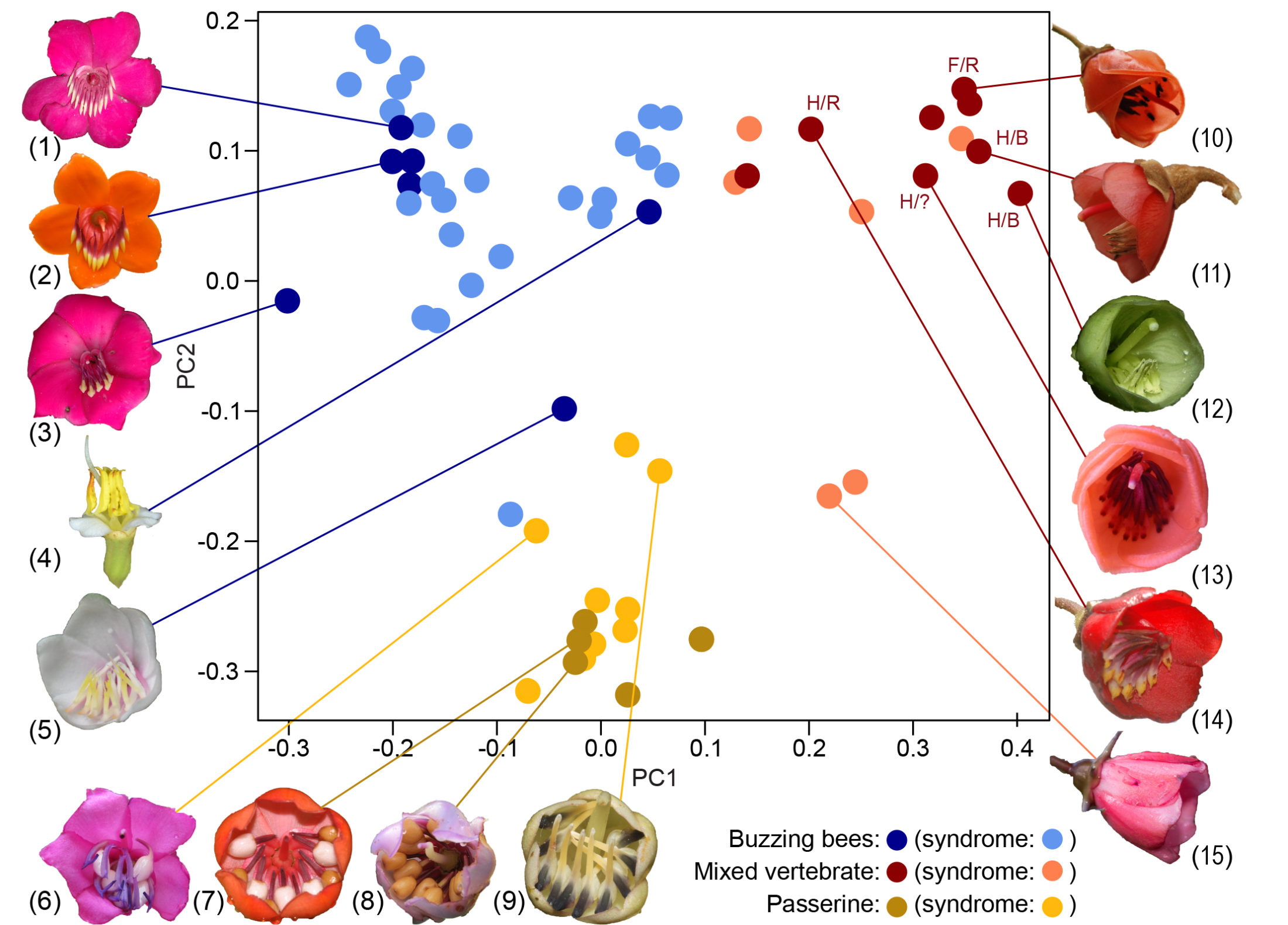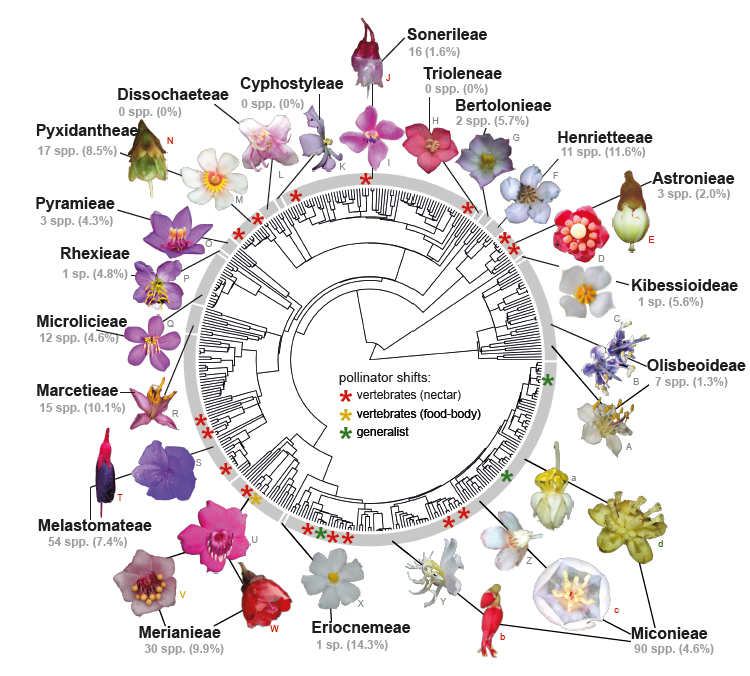Research
Merianieae – pollinator shifts and Andean plant diversification
Merianieae are a tribe of ca. 300 species in the large tropical plant family Melastomataceae, and are widely distributed across the Neotropics, including the Amazon Basin, Guiana Shield, Atlantic Forest, Antillean islands, Central America and, importantly, the Andes mountains, where they are most speciose. As in many other tropical lineages, the natural history of Merianieae was poorly understood when Agnes started working on the group in 2012, and no molecular phylogeny was available at the time.

Since 2012, we have conducted in-depth investigations of the pollination biology of more than 25 Merianieae species to establish a solid baseline knowledge of natural history for the group. In extensive field expeditions, we discovered a completely novel passerine pollination system and rodent pollination in the páramos of Southern Ecuador. Further, we could document that vertebrates are more efficient pollinators than bees on Merianieae flowers in tropical mountains, resulting in higher fruit set and lower population genetic differentiation in vertebrate-pollinated species. Through collaborative efforts, we have further produced a molecular phylogeny for the group, which is currently being expanded by collaborators using NGS technologies. This setup now allows us to take a broad, comparative approach not only to investigate the causes and consequences of pollinator shifts, but also to explore the intertwined roles of geology, historic biogeography, abiotic climatic niche evolution and biotic interactions in driving lineage diversification.
Pantropical pollination syndromes across Melastomataceae
 Despite decades of research on pollinator-mediated selection, the mechanisms and processes by which flowers evolve and diversify remain elusive. Are there floral traits which are evolutionarily more labile? Do certain floral traits evolve independently of other floral traits? And do some sets of traits evolve repeatedly and converge into pollination syndromes? Do developmental or functional constraints restrain flowers from converging into traditional pollination syndromes?
Despite decades of research on pollinator-mediated selection, the mechanisms and processes by which flowers evolve and diversify remain elusive. Are there floral traits which are evolutionarily more labile? Do certain floral traits evolve independently of other floral traits? And do some sets of traits evolve repeatedly and converge into pollination syndromes? Do developmental or functional constraints restrain flowers from converging into traditional pollination syndromes?
Melastomataceae harbour an exceptional diversity of different pollination strategies, but less than 300 species count with empirical pollinator observations. In recent projects, we focus on empirically documenting pollinators for more species across Melastomataceae, and collecting a detailed floral trait database for Melastomataceae encompassing more than 400 species across the globe. We use machine learning to predict pollinators for species hitherto unobserved in the field, and evaluate prediction accuracy by subsequent empirical observations when possible. We further use this dataset to address complex questions of floral trait evolution and large-scale patterns of trait-environment associations.
Buzz-pollination and biomechanics in Melastomataceae
Buzz-pollination refers to a functionally highly specialized pollination strategy where bees apply vibrations to flowers to extract pollen rewards. Pollen is concealed in tubular anthers which only open by a small, apical pore. Buzz-pollination has evolved in more than 65 plant families independently and is considered as an evolutionarily highly successful strategy (adaptive plateau). Although Melastomataceae represent the largest radiation of buzz-pollinated flowers, functional aspects of buzz-pollination in this group remain poorly understood.
We have recently been funded by the Austrian Science Fund (FWF, 2023/03, project number P-36766) to investigate the structural and functional properties of buzz-pollinated Melstomataceae combining High-Resolution X-Ray Computed Tomography with structural analyses of stamens and artificial buzzing experiments in the field. We are working both at a comparative macroevolutionary as well as at a community level to test a variety of hypotheses on the adaptive success of buzz-pollination and how multiple, co-occurring buzz-pollinated Melastomataceae species partition the bee pollination niche. This project includes a new collaboration with Ernst Csencsics at the Automation and Control Institute at the Technical University of Vienna to approach the functioniong of flowers from a mechanical perspective.
Plant-animal interactions in an environmental and evolutionary context
While the relation between abiotic environmental conditions and vegetative plant traits has been a central theme in plant ecology, how the structure and function of plant-animal interactions changes along environmental gradients is much less understood. Investigations in Merianieae have demonstrated that evolutionary pollinator shifts were not a pre-requesite for Andean colonization, but likely a consequence of the reduced pollination efficiency of bees in the rough mountain climate.
Understanding whether there are general rules in how environmental factors drive pollinator shifts, under which conditions ancestral pollinators are maintained, and how the abiotic environmental context modulates interactions also among co-occurring plants, are major themes in our reserach. We tackle these questions through experimental fieldwork (i.e., pollination and breeding system experiments), population genomics, environmental niche modelling and comparative analyses, both in Melastomataceae and in European plant systems (i.e., in the European Alps).
